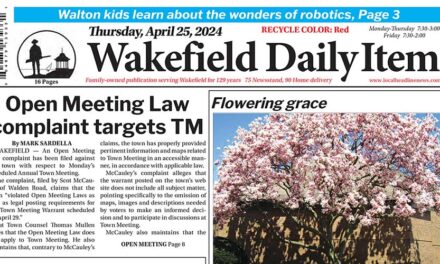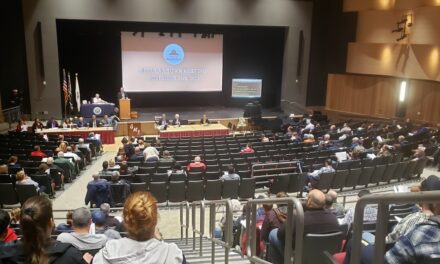By MARK SARDELLA
WAKEFIELD — Wakefield’s residential taxpayers will pay, on average, 5 percent more than this year than they did last year, and commercial/industrial property (CIP) owners will pay an average of 5.65 percent more than last year.
The Board of Selectmen set the new tax rate for FY 2018 last night after holding the annual tax classification hearing. As has been their longstanding practice, the board set the rates in such a way as to afford residential property owners the lowest allowable rate under law, with the commercial/industrial sector picking up the difference.
Director of Assessments Victor Santaniello made his recommendations to the selectmen, with Board of Assessors members Yano Tine and Jan D’Addario alongside.
In approving Santaniello’s recommendations, the selectmen set the residential tax rate at $12.95 per $1,000 of valuation. The CIP rate was set at $25.61.
That translates to a residential tax bill of $6,455 on the average single-family home valued at $498,500. The average commercial property valued at $1,311,200 will pay $33,580 in taxes in the current fiscal year.
“For the past several years,” Santaniello said, “the Board of Selectmen has opted to raise the tax levy less than the allowable Proposition 2 1/2 limit.”
They have elected to do the same thing this year, he noted.
“By not raising this additional $627,000 of tax levy, the residential tax rate is reduced by $0.12 and the CIP rate reduced by $0.23. It translates into a $60 average savings for residential taxpayers and $301 for CIP classes of properties.”
He pointed out that the Galvin Middle School debt exclusion increases the average residential tax bill by just over $200 and adds just over $1,000 to the average commercial tax bill.
“FY 2018 is the fourth year of the full debt exclusion for the new Galvin Middle School,” Santaniello noted. “The debt exclusion adds $2,408,672 to the town’s FY 2018 total tax levy. It adds $0.44 to the residential tax rate or $219 to the average single-family tax bill, and $0.88 to the CIP Rate or $1,154 to the average commercial tax bill.”
He noted that the number of home sales in Wakefield have been stable, with 218 in 2015 and 231 in 2016. The average sale price in 2015 was $492,971, and $513,956 (+ 4.25 percent) in 2016.
Santaniello also presented a comparison of tax rates in towns contiguous to Wakefield and noted that with the exception of Saugus, which has the Route 1 business district, residential properties in Wakefield realize the lowest possible share of the local tax burden.
Selectman Edward Dombroski questioned Santaniello about the 5 percent tax hike, noting that most taxpayers are not seeing a 5 percent increase in their incomes. He wanted to know what the board could do to help homeowners.
“I don’t think residents can keep pace,” he said, noting that in 2006 the average residential tax bill was $3,828 and it will now be $6,455. He also noted that residential water bills also go up every year, adding to the burden on the single-family home owner.
“I just think we need to do better,” he said. “I don’t want to see taxpayers priced out of the community.”
Santaniello noted that the selectmen had already increased the exemption for senior citizens. He noted that stimulating more commercial development could help to lessen the burden on the residential side. He also noted that his department has not seen a lot of properties going to tax title, which would be an indicator of people having trouble paying their taxes.
The Board of Selectmen also voted last night not to offer an “Open Space Discount.” As Santaniello explained, an Open Space Discount is defined as “land which is not otherwise classified and which is not taxable under provisions of Chapters 61A or 61B, or taxable under a permanent conservation restriction…not held for the production of income but maintained in an open or natural condition and which contributes significantly to the benefit and enjoyment of the public.”
“A maximum exemption of 25 percent may be adopted,” he said, “however the town has never voted a discount for open space since no properties have been identified which fulfill this section,” Santaniello told the board.
The selectmen also declined to offer a Residential Exemption. As Santaniello pointed out, this exemption has only been adopted in a handful of communities including Boston, Cambridge, Chelsea and Brookline and it is not designed to work in communities like Wakefield where most homes are owner-occupied.
The selectmen voted not to offer a Small Commercial Exemption. Santaniello explained that the Assessing Department is unaware of any businesses in town meeting the legal requirements for this exemption.




